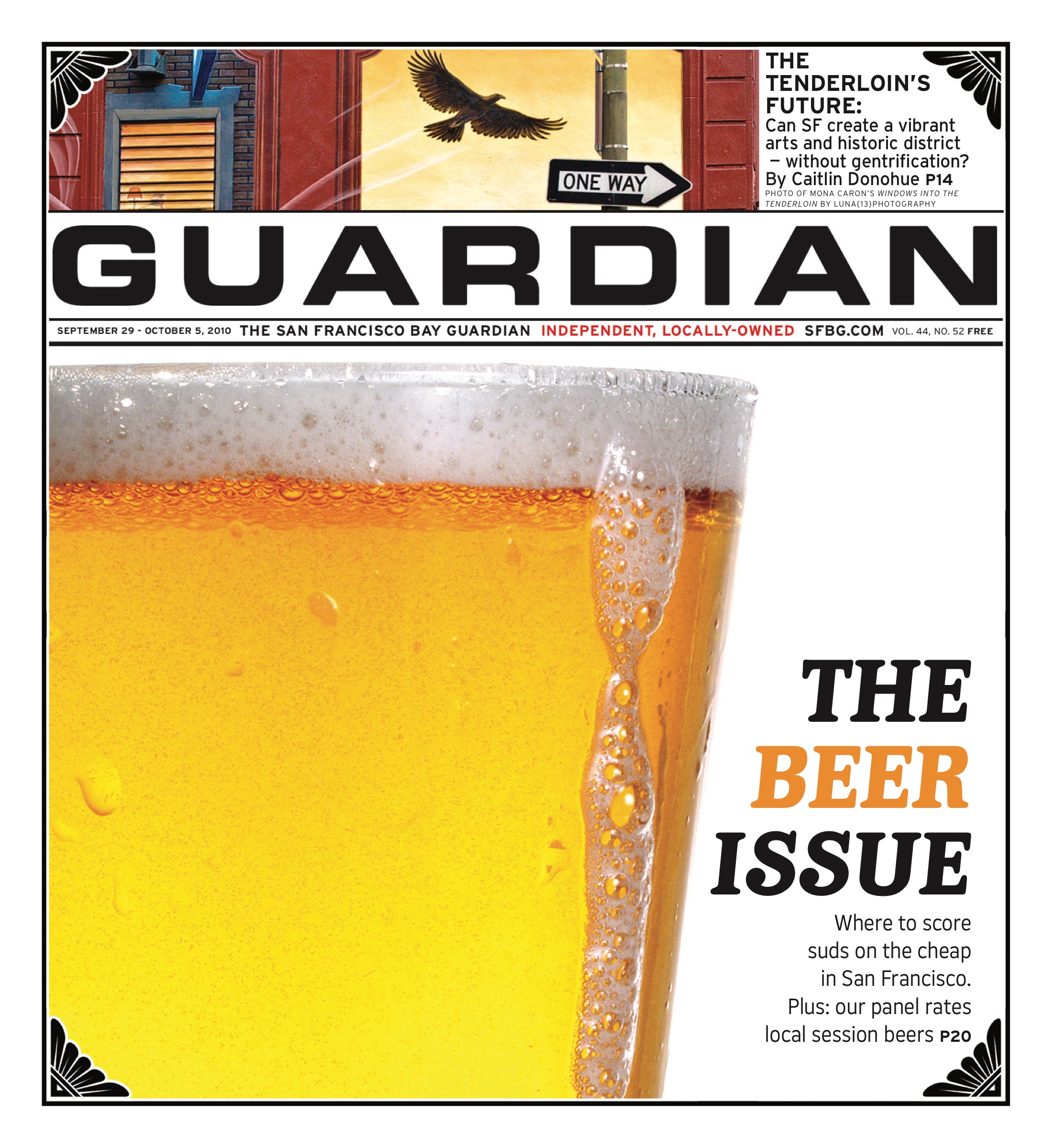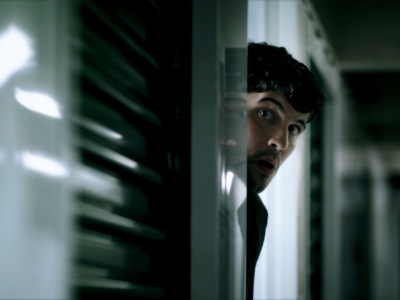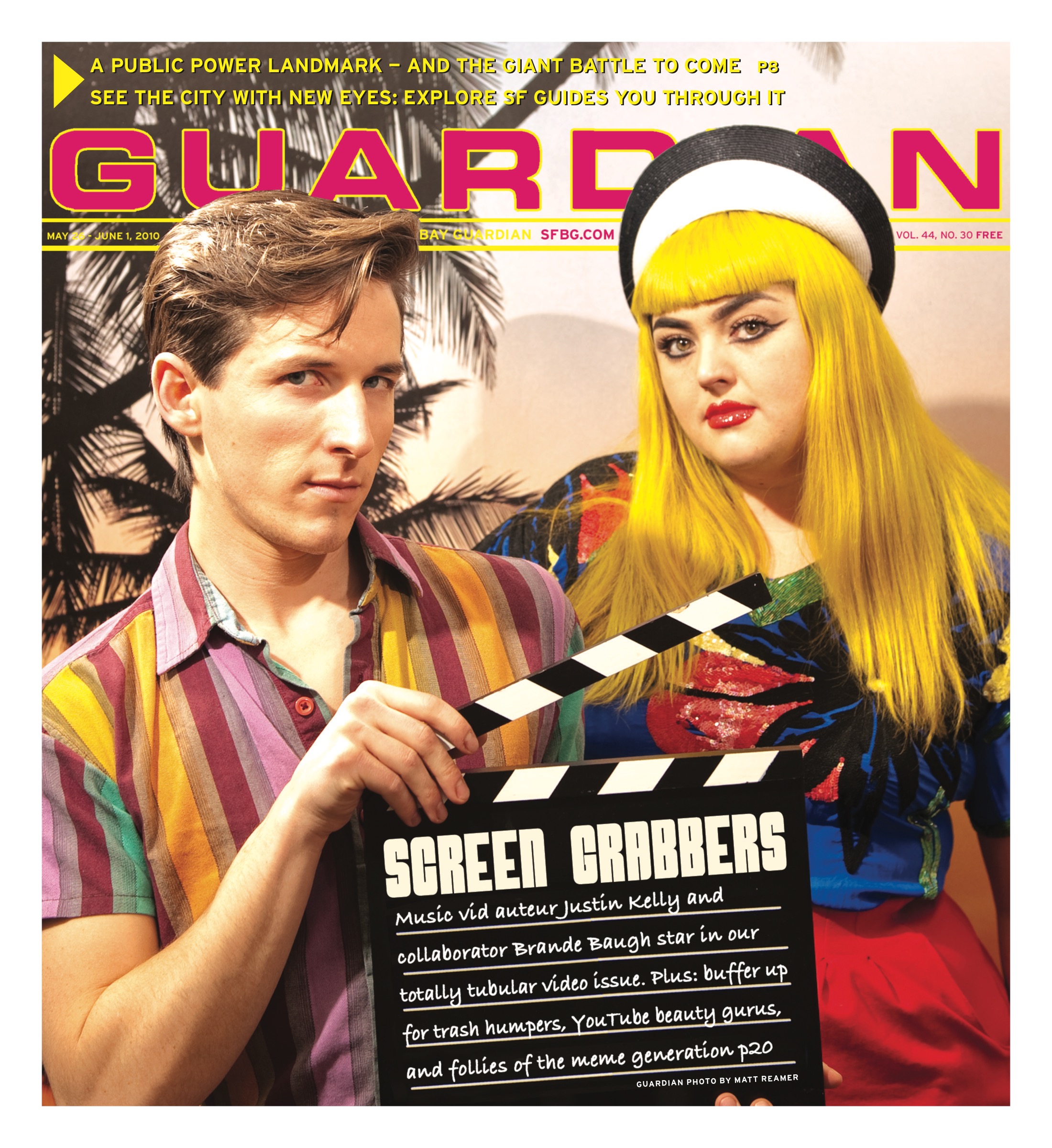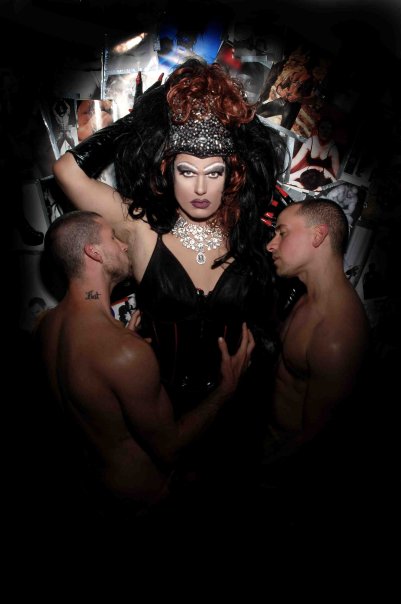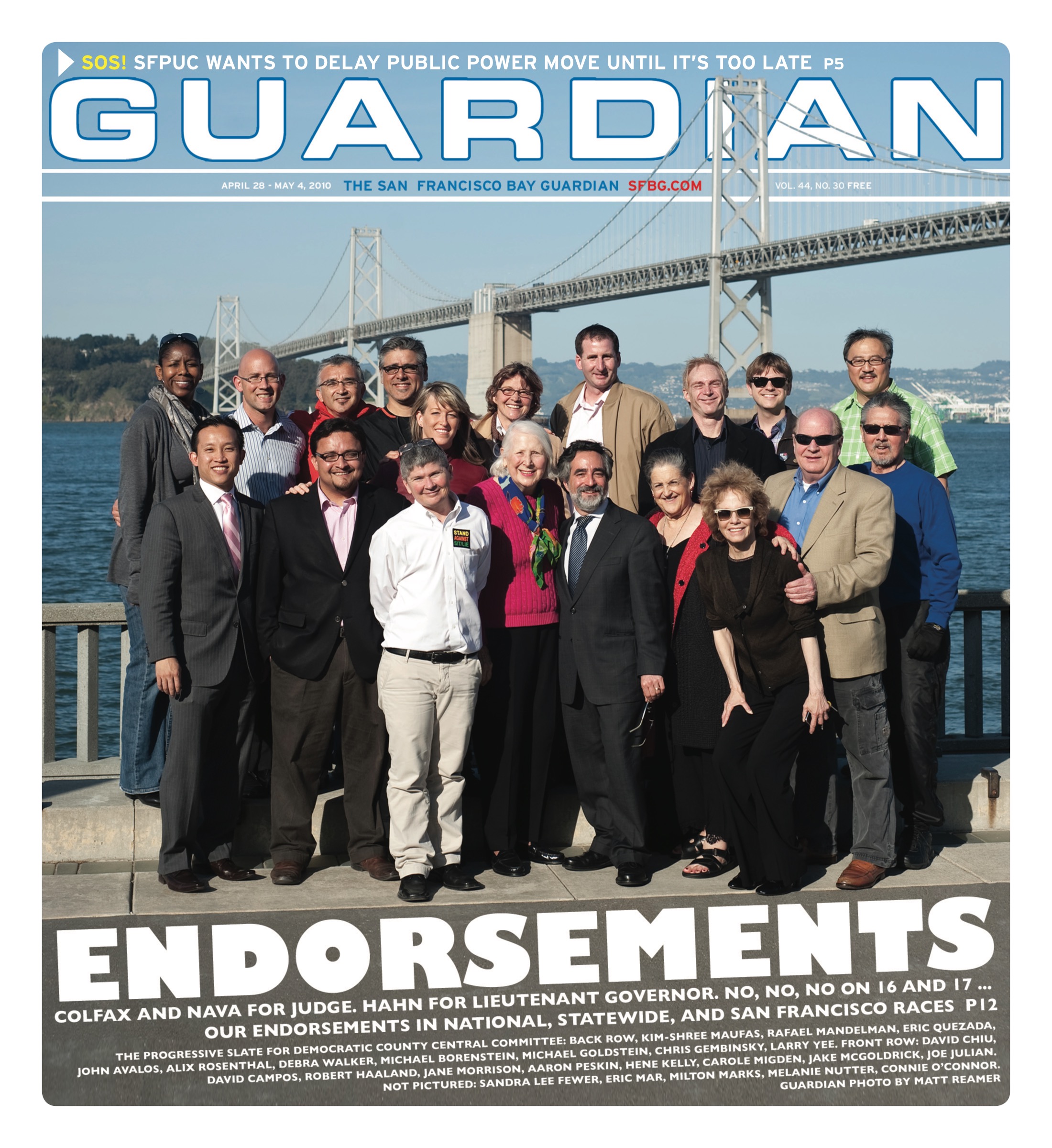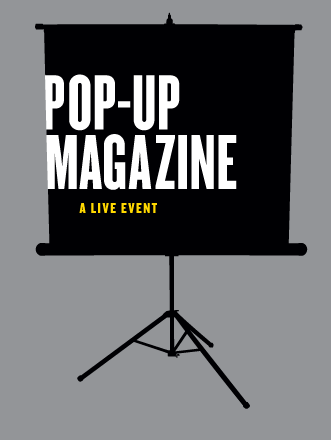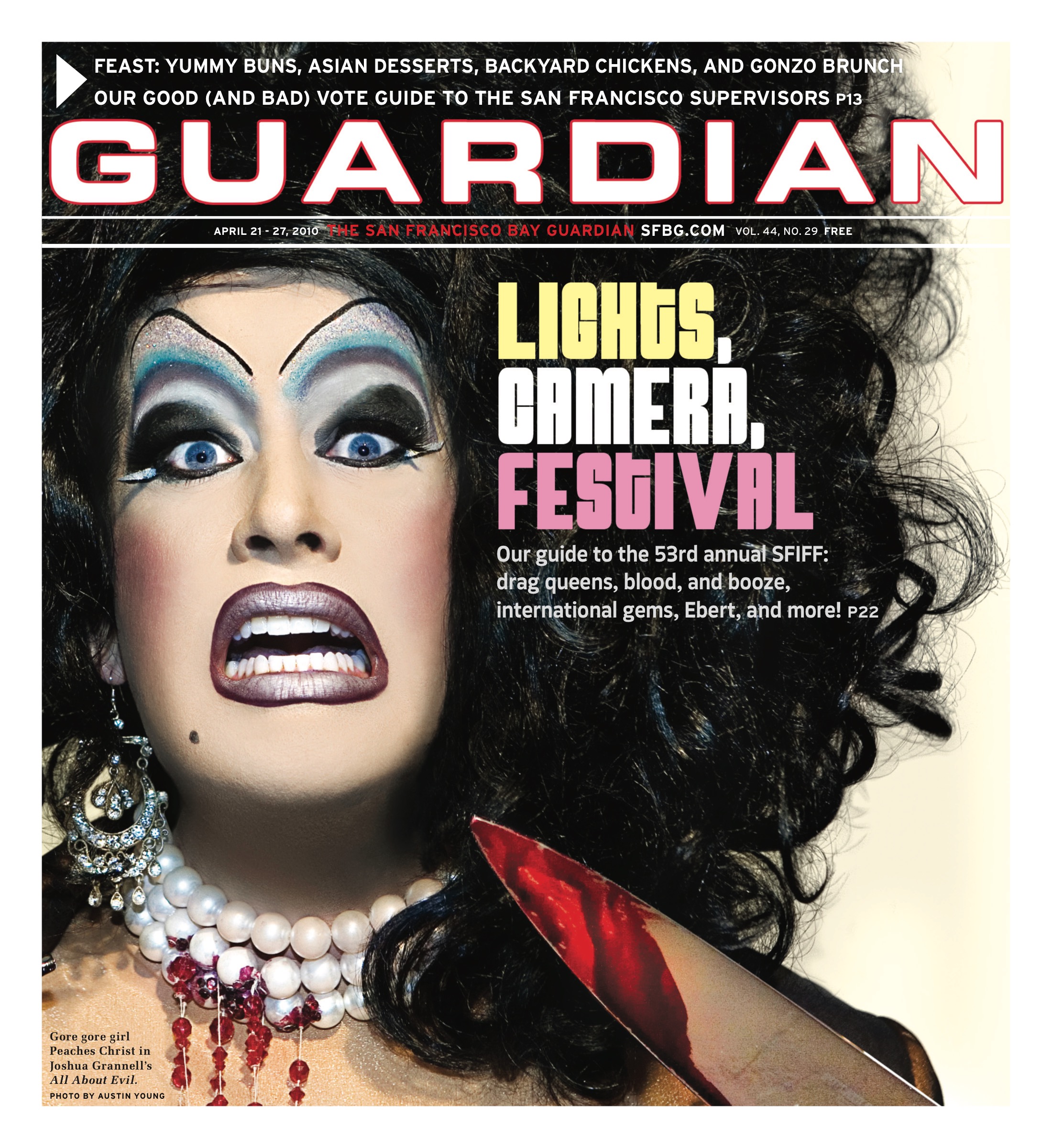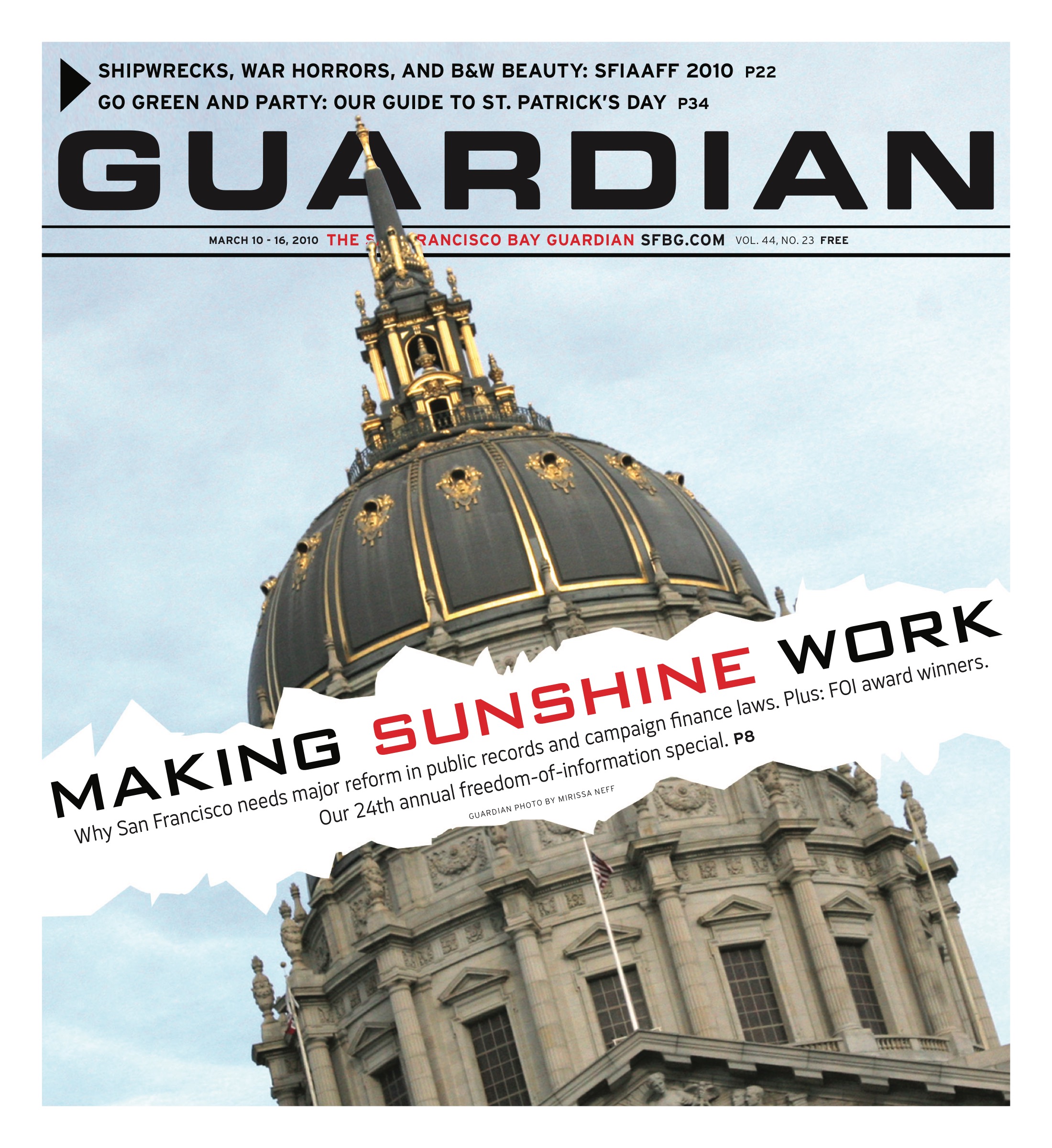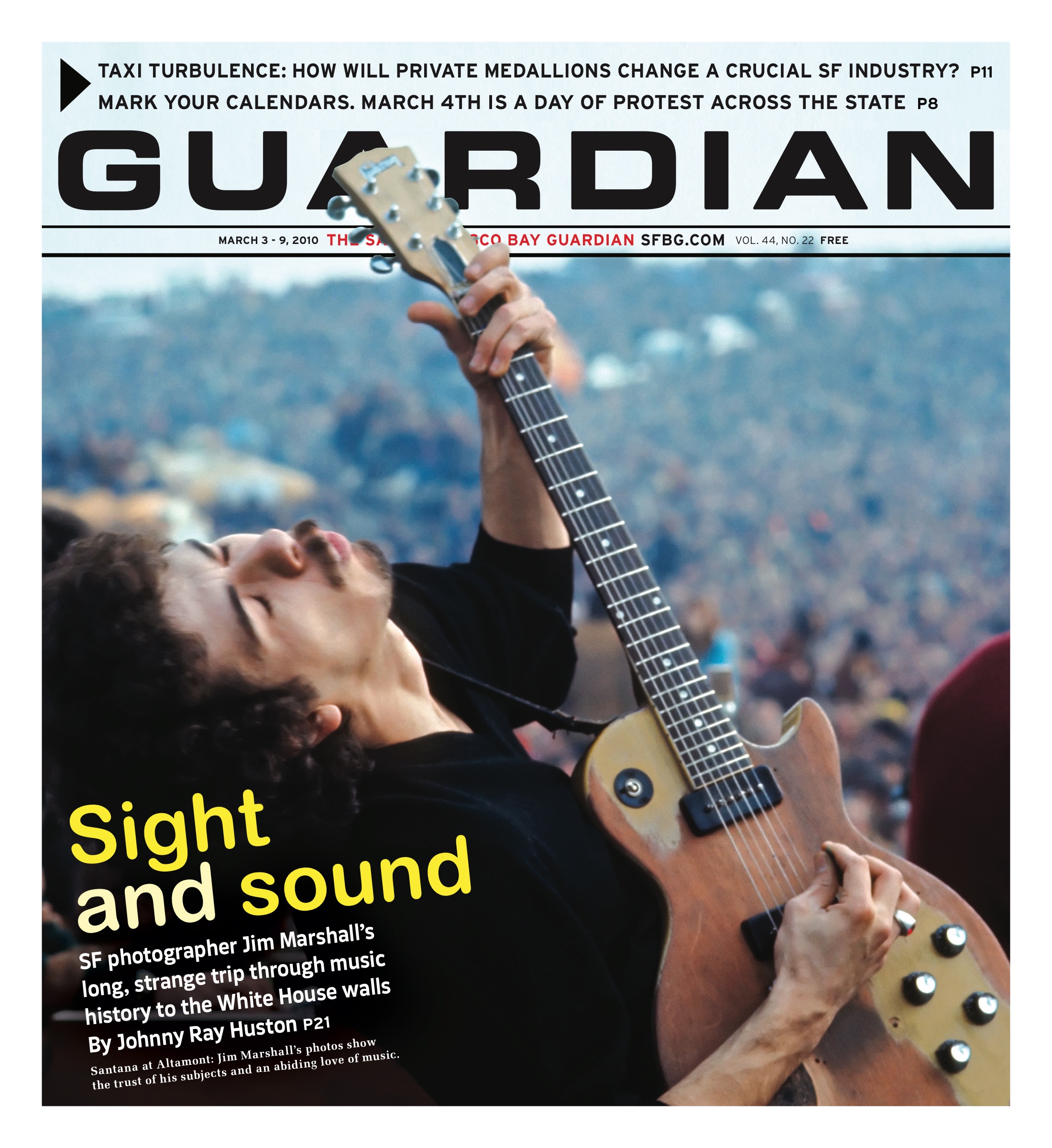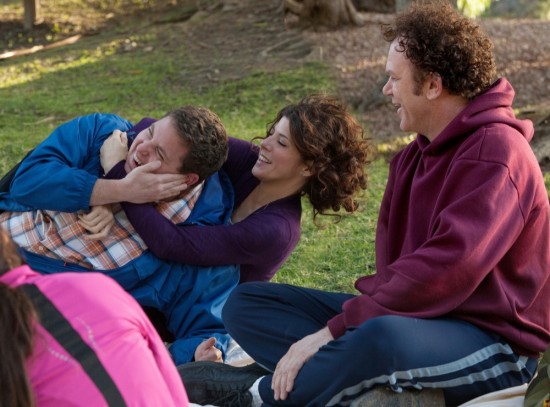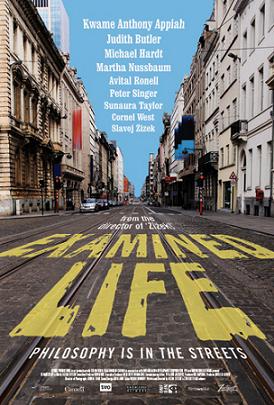Film listings are edited by Cheryl Eddy. Reviewers are Kimberly Chun, Michelle Devereaux, Peter Galvin, Max Goldberg, Dennis Harvey, Johnny Ray Huston, Louis Peitzman, Lynn Rapoport, Ben Richardson, and Matt Sussman. The film intern is Ryan Prendiville. For rep house showtimes, see Rep Clock. For first-run showtimes, see Movie Guide.
MILL VALLEY FILM FESTIVAL
The 33rd Mill Valley Film Festival runs Oct 7-17 at 142 Throckmorton Theatre, 142 Throckmorton, Mill Valley; Century Cinema, 41 Tamal Vista, Corte Madera; Smith Rafael Film Center, 1118 Fourth St, San Rafael; and CinéArts@Sequoia, 25 Throckmorton, Mill Valley. For tickets (most shows $12.50), call 1-877-874-6833 or visit www.mvff.com. "5@5" events are short-film programs. All times p.m. unless otherwise indicated.
THURS/7
Rafael The King’s Speech 7.
Sequoia Conviction 7, 7:15. Nowhere Boy 9:45.
FRI/8
Rafael Cut Poison Burn 6. Katalin Varga 6:30. "Spotlight on Alejandro González Iñárritu:" Biutiful 7. Tehran Tehran 8:30. Estigmas 8:45.
Sequoia "5@5: Gimme Some Truth" 5. Made in Dagenham 6:30. Queen of Hearts 7:15. Desert Flower 9. Dumas 9:30.
Throck "John Lennon at 70: A Live Concert" 8.
SAT/9
Rafael Eep! 10:30am. "New Movies Lab: The Future of Distribution" noon. TBA 12:15. Space, Land and Time 1. Tehran Tehran 2:15. Patagonia 3:15. Opal 3:30. Adrift 4:45. From a Whisper 6. "Tribute to Edward Norton:" Stone 7. Sand 7:15. About Her Brother 8:15. Everyday Sunshine: The Story of Fishbone 9:30.
Sequoia The Indian 11am. Food Stamped 1. The Reverse 2:45. Child of Giants 3:30. Kawasaki’s Rose 5:15. Puzzle 6:15. Love Crimes 7:30. The River Why 8:15. "Hi De Ho Show" 10.
Throck "Children’s Film Fest Opening Party Extravaganza" 12:30. "The Jay Clay Trilogy" 4. Ed Hardy: Tattoo the World 7:30.
SUN/10
Rafael Estigmas 12:30. Cosmonauts 12:45. Most Valuable Players 1. Becloud 2:45. The Tempest 3. Lesson Plan: Story of the Third Wave 3:30. About Her Brother 5:30. "Centerpiece:" Miral 5:45. Atomic Mom 6. Cut Poison Burn 6:15. Mr. Bjarnfredarson 8:30. Desert Flower 9.
Sequoia Twigson 11am. Sebbe noon. Precious Life 2. Moloch Tropical 2:15. From a Whisper 4:45. Cruz Reynoso 5. Leave Them Laughing 7. TBA 7:15. Ed Hardy: Tattoo the World 9:30.
Throck The Crocodiles 1:30. Truth Be Told 4:15. "Cinemasports" 8.
MON/11
Rafael "5@5: Just Like Starting Over" 5. The Two Horses of Genghis Khan 6. Precious Life 6:15. Cruz Reynoso 6:45. Child of Giants 8:30. Of Love and Other Demons 8:45. Kawasaki’s Rose 9:15.
Sequoia Dumas 4:45. "5@5: Watching the Wheels" 5. To Educate a Girl 7. Made in Dagenham 7:15. TBA 9:30.
Throck Space, Land and Time 7.
TUES/12
Cinema Star Wars Episode V: The Empire Strikes Back 6:30.
Rafael "5@5: Gimme Some Truth" 5. Food Stamped 6. Blue Valentine 6:15. Opal 7. Leave Them Laughing 8:30. Black Field 9. Sand 9:15.
Sequoia "5@5: Working Class Hero" 5. Queen of the Sun 6. Cast Me If You Can 7. Kung Fu Chefs 8:30. Sebbe 9:30.
OPENING
Enter the Void See "Noé Thanks." (2:17) Bridge, Shattuck.
*Grant Morrison: Talking With Gods The common stereotypes of a comic book writer’s life usually don’t include tales of swinging sex clubs, playing in rock bands, dressing in drag, and diving headfirst into the world of psychedelic drugs. Scottish-born artist Grant Morrison, on the other hand, has built a reputation for himself as a sort of comic world bad-boy, while putting his psychologically dark, surreal stamp on comics such as The Invisibles, Doom Patrol and Batman: Arkham Asylum. Talking with Gods is pretty traditional in its talking-head retelling of Morrison’s career, and at times goes a little overboard with peers and coworkers trying hard to sell his shaman-like persona. But comic fans will eat this stuff up, and newbies can get a sense of how far this medium has come from just being for the kids. (1:30) Roxie. (Landon Moblad)
I Spit on Your Grave Riding on the still-shocking premise of Meir Zarchi’s 1978 exploitation flick and given a cranked-up revamp — post-9/11 video beheadings, torture horror offerings a la Hostel (2005) and the Saw series — this unrated remake arrives with its initial writer-director’s blessing (Zarchi co-executive produced), while foregrounding the hillbilly dread of the original and amplifying its qualities as a not-quite-literary female Deliverance (1972) with an emphasis on no-holds-barred, gorily poetic revenge. The spare framework of the original remains the same: Jennifer Hills (Sarah Butler) is a writer working on a novel and in search of peace and quiet. She finds some unsettling quiet in an isolated rural cabin, but little peace as director Steven R. Monroe aims the hand-held on the farm implements that will come in all-too-handy in the second half of the film. Jennifer’s run-ins with lascivious, sadistic locals (Daniel Frenzies, Jeff Branson, Rodney Eastman, and Andrew Howard) escalate into scary, bullying cat-and-mouse games and continue ratcheting up until Jennifer has been brutally gang-raped, all of which is documented on video and is sickeningly extended for the audience in turn. The rest of the film turns the tables, gruesomely, on the torturers as they run scared through the always dark, beautiful, impervious woods, and Jennifer becomes a kind of vengeful ghost, a sister spirit of The Ring goblin-girl, sans psychology, contrition, and on-camera consequences. In place of the sad-Buster-faced Camille Keaton in the original is the wraith-thin Butler, who turns in a necessarily brave performance, though, through little fault of her own, her character remains startlingly opaque — the unlikely object of men’s most offensive sexual fantasies turned into the savage instrument, hedge clippers sharpened, of women’s ruthless revenge fantasies. (1:47) Metreon. (Chun)
It’s Kind of a Funny Story Largely self-inflicted scholastic pressures having manifested themselves in an array of symptoms from "stress vomiting" to suicidal ideations, depressive Brooklyn teen Craig (Keir Gilchrist) rides his bicycle to a local hospital and announces he needs help. Expecting to be fussed over a bit and given some nice tranquilizing pill, he’s dismayed instead when the no-nonsense intake psychiatrist (Viola Davis) tells him it’s her obligation to commit him for a minimum five days’ observation. Worse, the facility’s youth psych ward is being renovated, so he’s tossed in with the crazy adults. Other residents are led by comely but self-cutting fellow teen Noelle (Emma Roberts) and mentoring yet self-sabotaging Bobby (Zach Galifianakis). Based on Ned Vizzini’s semi-autobiographical novel, Funny Story is well acted (even or especially by the atypically subdued Galifianakis), its mixed humor and poignancy nicely negotiated by Anna Boden and Ryan Fleck in their third feature. But compared to the duo’s prior Half Nelson (2006) and Sugar (2008), this seems conventional and a little soft — hewing dangerously close to that sentimentally twee notion (popularized in 1966’s King of Hearts, 1975’s One Flew Over the Cuckoo’s Nest, et al.) that we’re all "crazy" and lunatics are really the wisest fools of all. Heartwarming life lessons get learned, needless to say. The cuteness climaxes with an "Under Pressure" music video fantasy that belongs in an episode of Glee — not, perhaps, in a movie that begins with a 15-year-old seriously considering jumping from a bridge. (1:51) California, Embarcadero, Piedmont. (Harvey)
Life as We Know It "You have poo on your face." (1:52) Presidio.
My Soul to Take Wes Craven sure loves serial killers. (1:46)
*Secretariat In this biopic of one of the most-celebrated horses in U.S. history, Denver housewife and mother of four Penny Chenery (Diane Lane) returns to the Kentucky horse-breeding farm where she grew up, drawn to the project of reviving the ailing business. She pins her hopes on an unborn foal of questionable marketability, who she comes to believe is destined for greatness. Secretariat — or Big Red, as he’s known to his friends — is raised in the light of this belief by a small, reverent circle including his trainer (John Malkovich), his jockey (professional rider Otto Thorwarth), his groom (True Blood‘s Nelsan Ellis), and the farm’s longtime secretary (Margo Martindale), and he goes on to attain the status of a national folk hero. Director Randall Wallace has crafted an appropriately epic tale — and heavily salted the film with messages about unswerving faith and determination and hope and glory, mostly delivered in ringing, overwrought tones by Lane (which undercuts the pleasure of seeing her character quietly pursue a larger setting than the domestic scene she inhabits at Secretariat‘s outset). But somehow it’s harder to poke fun when the hero of the story is a horse, especially one of such majestic stature and jaw-dropping prowess. Each time Secretariat goes surging around the oval, in one of the film’s white-knuckle race sequences, the clichés fly and then fall away like dirt on the track. (1:56) Presidio, Shattuck. (Rapoport)
ONGOING
*The Agony and the Ecstasy of Phil Spector Alternately slavish and critical, simultaneously buying into and subtly resisting the hype, The Agony and the Ecstasy of Phil Spector is a bit like the renowned producer himself, who said this to biographer Mick Brown in 2007’s Tearing Down the Wall of Sound: the Rise and Fall of Phil Spector: "I have a bipolar personality … I have devils inside that fight me. And I’m my own worst enemy … I would say I’m probably relatively insane." You can see why director Vikram Jayanti scored the interview with Spector at the center of Agony, since he gets on board the musicmaker’s bifurcated, multichannel tip. The doc is both fascinating and monotonous, respectful of Spector’s achievements as well as the sensation surrounding his blighted celebrity. The filmmaker stays away from the specifics of the night in 2003 when Lana Clarkson was found dead at Spector’s mansion, while recontextualizing the producer’s words and music with images culled from the murder trial and other footage. The end result is an innuendo-laden pastiche that resembles an echo chamber reverberating with all the doomed dramatics of "He Hit Me (It Felt Like a Kiss)." (1:42) Roxie. (Chun)
*Buried Spanish director Rodrigo Cortés’ first English-language feature has one of the most deeply unsettling openings in recent memory: a pitch-black screen gradually soundtracked by the waking, disorientation, and frantic scratching made by Paul Conroy (Ryan Reynolds) as he realizes he’s been buried alive. A U.S. civilian contractor (the good, reconstructionist kind, not the gun-crazy, mercenary "security" type) in Iraq, he struggles to calm down as he uses a pocket lighter to view the coffin he’s trapped in. Finding a flashlight and cell phone, he soon receives a call from his kidnappers informing he has just 90 minutes of oxygen (and probably less time on the phone’s running-down battery) to raise a considerable ransom. Chris Sparling’s clever screenplay and Cortés’ surprisingly cinematic treatment (given the single location’s extreme claustrophobia) keep this potentially one-note real-world horror movie nail-bitingly tense throughout, while Reynolds runs a grueling emotive gamut with aplomb. (1:34) SF Center. (Harvey)
Cairo Time (1:29) Embarcadero, Shattuck.
Case 39 (1:49) 1000 Van Ness.
Catfish Please do not reveal the secret to Catfish — relax, I’m not going to. What I will say is this: Catfish’s uber-secretive, Paranormal Activity-esque ad campaign is effective, but the film ultimately stands on its own merits. This is an intriguing, relatable documentary, and if the studio feels that they’ll sell more tickets by promoting it in a certain way, so be it. Without giving away too much, Catfish is the spontaneous documentary that arose when filmmakers Rel Schulman and Henry Joost began filming Rel’s brother, Nev. Like so many of us, Nev finds himself drawn to a person he’s never met — embarking on a relationship through Facebook photos and wall posts. Of course, as is so often the case with the internet, nothing is quite what it seems. Catfish has already found its critics, particularly those who insist the documentary is a fake. I believe it, but either way it’s an impressive achievement: the best film yet about social networking. (1:26) Sundance Kabuki. (Peitzman)
*The Desert of Forbidden Art Uzbekistan probably hasn’t been at the top of your vacation wish list, but it might be after seeing this documentary by Tchavdar Georgiev and Amanda Pope — at least if you’re a modern art lover. It centers on the Nukus Museum, an extraordinary institution founded by the late Igor Savitsky, a frustrated painter who came here first from Moscow as an archaeologist, then became fascinated with the remote region’s ethnic folk artifacts. By 1966 official policy had turned from wiping out regional traditions and identities to embracing them, so he was given public funds to showcase his collection here. But unbeknownst to the bureaucrats back home (until it was too late), he’d already found a new passion, and was busy funneling his budget toward it: Finding and archiving a wealth of virtually unknown Soviet modern art that had been created without notice (often in hiding) since Stalin’s cultural watchdogs condemned the once-favored avant-garde movement of the 1920s in favor of sentimental, propagandic "Soviet realism." This stuff is the bomb — almost literally, since workaholic Savitsky finally died in 1984 of excess exposure to toxic restoration chemicals. There are poignant and colorful human stories here, but The Desert of Forbidden Art‘s exhilarating primary appeal lies in the fact that it features probably more eye-poppingly great visual art that you’ve never seen or known about before than quite possibly any documentary before it. You may well walk out with a question: so, are there cheap flights to Uzbekistan? (1:20) Four Star. (Harvey)
*Easy A Take the sex out of a teen sex comedy and hone in on the heard-it-yesterday info overload of the highly social-networked ’00s, and you get Easy A, a whip-smart striver looking to give a whole new definition to fast fiction. The brainy grandchild of 1930s screwball comedies and the knowing offspring of more recent spoofs of the Clearasil years like Clueless (1995) — with blood ties to the on-point pop of pater familias John Hughes — Easy A doesn’t quite aspire to the grainy, your-so-called-reality of YouTube auteurs, à la The Virginity Hit, though Bert V. Royal’s script is just as steeped in the culture of viral gossip and TMZ-writ-small, as well as the high-low literary and cinematic referents, that ’80s babies-and-up were succored on. Welcome to the postmodern mixed-up world of the girl who gets straight As, a marked contrast to all the bromancin’ going down in other parts of the cineplex: Olive Penderghast (Emma Stone) is curious enough to venture fully down the rabbit hole of bad-girl schoolyard celebrity after fabricating a story about losing her virginity. Despite the swelling disapproval of Marianne (Amanda Bynes) and her virginal Christian fundamentalist crew, Olive’s soon giving pity faux-fucks to all the misfits on campus in exchange for gift cards to big-box stores. Her hilariously staged tryst with classmate Brandon (Dan Byrd), who’s sick of getting beaten up every day because he’s gay, is up there with anything in Ferris Bueller’s Day Off (1986). And though Easy A often seems pitched more to adults, like Olive’s wise-cracking parents (Patricia Clarkson and Stanley Tucci), its entertainingly self-aware fiction is still likely to bridge generational divides as much as anything on Facebook. (1:30) 1000 Van Ness, Presidio, Shattuck. (Chun)
*A Film Unfinished Documentaries that "tell" the Holocaust tend to employ archival footage generically as a kind of historical flavoring. It’s rare that we are asked to contemplate either the provenance of the images or the individual lives depicted. Yael Hersonski’s A Film Unfinished simultaneously confronts both of these gaps with a taut historiography of several reels of Nazi propaganda footage. Even in the German film’s inchoate form, we easily apprehend the propagandistic moves to further manipulate an already constructed reality (the Warsaw Ghetto) for objective "proof" of the necessity of Hitler’s Final Solution. Yet here before us, flowing at the speed of life, are the faces and places that would be destroyed within months of the filming. Hersonski attempts to extricate the documentary value of this footage using frame-speed manipulations and edits that call attention to telling movements. She also films elderly survivors watching the footage alone in a darkened theater. In their capacity for recognition and incredulousness, they unravel the German point of view. By weaving these live responses with diary entries of those consigned to the ghetto along with the deposition of a German cameraman, Hersonski draws a fragmentary, highly specific account of the Holocaust’s crisis of representation. (1:29) Opera Plaza, Shattuck. (Goldberg)
Fresh Fresh may be a surprisingly hard sell in the Bay Area. Even though self-styled gourmands are as abundant here as subsidized corn in Iowa, they may have already seen 2008’s Food, Inc. And although Fresh bills itself as a next step in a dialogue on sustainable agriculture, it’s a bit of retread. Author and reluctant leader of the movement Michael Pollan (The Omnivore’s Dilemma) and small farm messiah Joel Salatin make obligatory appearances, if only in less depth than Food, Inc. While no more talky than Food Inc., Fresh‘s production frequently relies on stock footage against stagy interviews. The effect is more folksy than insightful. When it works, particularly in sections featuring urban farmer Will Allen, Fresh comes off as hopeful. But if you’re looking for a tool to educate someone about why they shouldn’t buy groceries at Target, you might want to shop around. (1:12) Red Vic, Smith Rafael. (Prendiville)
*The Girl Who Played With Fire Lisbeth Salander is cooler than you are. The heroine of Stieg Larsson’s bestselling book series is fierce, mysterious, and utterly captivating: in the movie adaptations, she’s perfectly realized by Noomi Rapace, who has the power to transform Lisbeth from literary hero to film icon. Rapace first impressed audiences in The Girl With the Dragon Tattoo (2009), a faithful adaptation of Larsson’s premiere novel, and she returns as Lisbeth in The Girl Who Played With Fire. The sequel, as is often the case, isn’t quite on par with the original, but it’s still a page-to-screen success. And while the first film spent equal time on journalist Mikael Blomkvist (Michael Nyqvist), The Girl Who Played With Fire is almost entirely Lisbeth’s story. Sure, there’s more to the movie than the hacker-turned-sleuth — and the actor who plays her — but she carries the film. Rapace is Lisbeth; Lisbeth is Rapace. I’d watch both in anything. (2:09) Lumiere, Shattuck. (Peitzman)
*Howl Beatniks get the Mad Men treatment — with a cast that includes that AMC hit’s Jon Hamm, playing the lawyer who defended the publisher of Allen Ginsberg’s quintessential rebel yell, Lawrence Ferlinghetti, against obscenity charges in San Francisco’s most celebrated trial of the 1950s. It’s fun to see that anally nostalgic aesthetic translated to ramshackle North Beach apartments and sophomoric, filthy-mouthed literary heroes. Not so much fun: the overly literal animation chosen by the directors (famed documentarians Rob Epstein and Jeffrey Friedman). Yes, parts of "Howl," the poem, are animated — unfortunately in a style that calls to mind bad 1980s French Canadian pseudo-spiritual arthouse schlock. Still, this brief slice of beats is juicy, confined to the trial and the tale of Ginsberg’s poetic and sexual awakening. James Franco is wonderful as the young, self-obsessed, epically needy yet still irresistible crank. It was the first time I found myself wishing to see more of Ginsberg naked. (1:30) Four Star, Smith Rafael, Sundance Kabuki. (Marke B.)
Jack Goes Boating Not all miserable people are interesting — sometimes they’re just miserable and dull. Case in point: all of the characters in Jack Goes Boating, adapted by Robert Glaudini from his play. The titular Jack (Philip Seymour Hoffman, who also directs) is an awkward limo driver with filthy dreads and an anger management problem. He does his best to court equally awkward Connie (Amy Ryan), while his best friends Clyde (John Ortiz) and Lucy (Daphne Rubin-Vega) watch their marriage collapse, spectacularly. Given the talent involved, Jack Goes Boating might be mistaken for a better film than it is. There are moments, in fact, when it’s almost good. But the movie is unpleasant on every level — and not in an engaging way, like far better Noah Baumbach films about dysfunction. The romance is strained and unrelatable: you want Jack and Connie to make it work, if only so that the movie can end. (1:29) Opera Plaza, Shattuck. (Peitzman)
*The Kids Are All Right In many ways, The Kids Are All Right is a straightforward family dramedy: it’s about parents trying to do what’s best for their children and struggling to keep their relationship together. But it’s also a film in which Jules (Julianne Moore) goes down on Nic (Annette Bening) while they’re watching gay porn. Director Lisa Cholodenko (1998’s High Art) co-wrote the script (with Stuart Blumberg), and the film’s blend between mainstream and queer is part of what makes Kids such an important — not to mention enjoyable — film. Despite presenting issues that might be contentious to large portions of the country, the movie maintains an approachability that’s often lacking in queer cinema. Of course, being in the gay mecca of the Bay Area skews things significantly — most locals wouldn’t bat an eye at Kids, which has Nic and Jules’ children inviting their biological father ("the sperm donor," played by Mark Ruffalo) into their lives. But for those outside the liberal bubble, the idea of a nontraditional family might be more eye-opening. It’s not a message movie, but Kids may still change minds. And even if it doesn’t, the film is a success that works chiefly because it isn’t heavy-handed. It refuses to take itself too seriously. At its best, Kids is laugh-out-loud funny, handling the heaviest of issues with grace and humor. (1:47) Opera Plaza. (Peitzman)
Last Train Home In disaster movies, there’s a familiar scene: panicked throngs press against barriers, crushing one another, pleading "I have to get through!" to impassive guards. Watching the documentary Last Train Home, you realize an over-dramatic Hollywood cliché is a depressing reality in other parts of the world, as workers in China annually endure massive crowds to get home for New Year’s. Filmmaker Lixin Fan focuses on one couple among the 130 million taking part in the world’s largest migration. Their sacrifice (being away from their children for work) is called into question when their daughter runs away to the city to sew jeans and party. By the producers of 2007’s equally cinematic Up the Yangtze, this doc unfolds like a scripted film, until the family’s conflict shatters the fourth wall, and you’re reminded that people actually have to endure intense hardships so that we can have cheap pants with 40-inch waists. (1:27) Lumiere, Shattuck. (Prendiville)
*Legend of the Guardians: The Owls of Ga’hoole Owl fever is everywhere — from the megahit Webcam trained on Molly the Barn Owl in San Marcos to the omnipresent ’70s-flavored owl necklaces designed by Real Housewife kook Kelly Bensimon. Animated fantasy Legend of the Guardians: The Owls of Ga’Hoole is yet another sign that the fascination hasn’t faded yet. Less sophisticated than Fantastic Mr. Fox (2009) and more straight-faced than this year’s Cats & Dogs: The Revenge of Kitty Galore, this animated talking-animal epic displays director Zach Snyder in family-friendly fantasy mode. While venturing out of the safety of their nest and attempting to test their wings, youthful barn owlet Soren (Jim Sturgess) and competitive brother Kludd (Ryan Kwanten) are captured by the hench-owls of Nyra (Helen Mirren) and Metalbeak (Joel Edgerton), two Aryan Nation-esque critters who style themselves as the Pure Ones. They’re bent on imposing a strict heirarchy on the owl kingdom, subjugating the "lesser" birds, and destroying a mythical crew of warrior owls called the Guardians. And thanks to Legend of the Guardians‘ cunning detail and solid 3-D effects, that world of good vs. evil takes on a breadth and depth that both children and adults can probably fly with. Though the owls’ eyes can seem a bit too cartoonishly, and wildly unrealistically, expressive, the director who made 300 (2006) and Watchman (2009) and creative team Animal Logic still can’t resist giving the kids a little gritty kick with bloodless yet visceral bird battle scenes, and those nuggets of mouse parts that the cute li’l owlets puke up. (1:31) 1000 Van Ness. (Chun)
Let Me In In 2008, chilly Swedish import Let the Right One In offered an alternative, and an antidote, to the first Twilight movie’s sparkly vampire fantasy. John Ajvide Lindqvist adapted his own book for director Tomas Alfredson, and the tale — about a bullied, neglected 12-year-old boy who befriends the seemingly same-aged, mysterious new girl in his apartment complex, only to discover her monstrous secret — became a favorite among critics and genre fans unafraid of foreign flicks. Just two years later, writer-director Matt Reeves (whose Cloverfield was also a 2008 release) offers his own take on Lindqvist’s story, with Kodi Smit-McPhee (stronger here than he was in last year’s The Road) and tween It Girl Chloë Grace Moretz (Kick-Ass) taking the leads, and Richard Jenkins, Elias Koteas, and current Mad Men scene-stealer Cara Buono playing the peripheral adults. Reeves’ version is just fine — he shifts the action to the snowy New Mexico mountains, and Americanizes the original’s 80s setting (Reagan clips, new wave radio hits) — but doesn’t bring enough new to the table to justify remaking what was already a pretty fantastic film. Still, horror fans who haven’t seen the original, or who can’t be bothered to read subtitles, will no doubt appreciate this atmospheric spin on the age-old shared belief that growing up really sucks. For my interview with Reeves, including his explanation of why he chose to do a remake of a film he greatly admired, check out www.sfbg.com/pixel_vision. (1:55) 1000 Van Ness, Shattuck. (Eddy)
*Machete Probably the first movie that was initially conceived solely as a fake-movie trailer (as part of Quentin Tarantino and Robert Rodriguez’s 2007 Grindhouse), Rodriguez’s Machete emerges in full-length form to take on everyone’s sky-high expectations. I mean, the trailer promised motorcycles soaring through flames, a gun-toting priest, and the line "You just fucked with the wrong Mexican." Fortunately, Machete the film does Machete the trailer proud; its deliberately silly revenge plot is both spot-on vintage homage and semi-serious commentary on America’s ongoing immigration debate. In addition, it features more severed limbs, gunshots to the head, irresponsible sex, and smirking Steven Seagal close-ups than any other movie in recent memory. Frequent Rodriguez supporting player Danny Trejo pretty much kills it as the title badass — but then, you already knew he would. (1:45) 1000 Van Ness. (Eddy)
*Mademoiselle Chambon Stéphane Brizé’s new Mademoiselle Chambon is a movie whose protagonists lunge toward each other — even though they shouldn’t, for their own sakes and everyone else’s. Grave-voiced, craggy-faced Jean (Vincent Lindon) is a construction-site laborer; Anne Marie (Aure Atika) his assembly-line worker wife; Jeremy (Arthur Le Hourerou) the eight-year-old offspring who’s already better educated than either of them. One day Anne Marie suffers a temporarily disabling factory accident, leaving Jean to pick up Jeremy from school. There, Jean first encounters Jeremy’s teacher, Véronique Chambon (Sandrine Kiberlain). She has the willowy body of a veteran ballet dancer and a naturally refined air — at least by his limited experiential standards. There’s an immediate if unadmitted spark between them, yet Mademoiselle Chambon doesn’t get cheap about it. None of these people are more than ordinary, kinda-attractive. As temptations and related tensions unravel their stability, Brize allows his characters to slip grip gracefully. No one behaves well, but they do behave credibly. Mademoiselle Chambon sees rational folk with well-organized lives stubbornly resisting a mutual pull whose logical outcome will surely suck for all concerned. It’s a fine, measured drama presented with typical Gallic insouciance — tenderly discreet even when conventional art and commerce shout for something more crudely dramatic. (1:41) Clay, Shattuck. (Harvey)
*Mao’s Last Dancer Based on the subject’s autobiography of the same name, this Australian-produced drama chronicles the real-life saga of Li Cunxin (played as child, teen, and adult by Huang Wen Bin, Chengwu Guo, and Chi Cao), who was plucked from his rural childhood village in 1972 to study far from home at the Beijing Dance Academy. He attracted notice from Houston Ballet artistic director Ben Stevenson (Bruce Greenwood) during a cultural-exchange visit, and was allowed to go abroad for a Texas summer residency. At first the film looks headed toward well-handled but slightly pat inspirational territory pitting bad China against good America, as it cuts between Li’s grueling training by (mostly) humorless Party ideologues, and his astonishment at the prosperity and freedom in a country he’d been programmed to believe was a capitalist hellhole of injustice and deprivation. (Though as a Chinese diplomat cautions, not untruthfully, he’s only been exposed to "the nice parts.") Swayed by love and other factors, Li created an international incident — tensely staged here — when he chose to defect rather than return home. But Jan Sardi’s script and reliable Aussie veteran Bruce Beresford’s direction refuse to settle for easy sentiment, despite a corny situation or two. Our hero’s new life
isn’t all dream-come-true, nor is his past renounced without serious consequence (a poignant Joan Chen essays his peasant mother). The generous ballet excerpts (only slightly marred by occasional slow-mo gimmickry) offer reward enough, but the film’s greatest achievement is its honestly earning the right to jerk a few tears. (1:57) Opera Plaza, Shattuck. (Harvey)
Never Let Me Go The time is not so long ago, and the atmosphere is of a rural England that resists change. So it takes a while for us to realize that this adaptation of Kazuo Ishiguro’s acclaimed book (by fellow novelist Alex Garland) takes place in an alternative recent past in which society has indeed changed in ways that are few, yet enormous. Raised at what appears to be a familiar if slightly peculiar English boarding school, the students of Hailsham are given limited but highly specific education preparing them for an adulthood of service. A short adulthood, that is, for they are clones grown from "originals," considered not quite human, their purpose being eventual willing harvest for organs by a populace whom medical science breakthroughs can now allow extraordinarily long lifespans. Placidly preparing for that future sacrifice are best friends Ruth (Keira Knightley), Tommy (Andrew Garfield), and Kathy (Carey Mulligan), the latter such a born accommodator that she doesn’t utter a peep of protest when Ruth grabs Tommy as her boyfriend — destroying all Kathy’s hopes and probably dimming Tommy’s somewhat as well. Directed by Mark Romanek (2002’s One Hour Photo), Never Let Me Go spans a couple of decades, but its aura of mournful melancholy never wavers. The results are well cast, handsomely outfitted (Rachel Portman contributes a plaintive string score), tasteful, and just a little bit more monotonous and less touching than you might hope. Not particularly plot-driven, this is a good film that’s also another illustration (like such recent examples as 2009’s The Road and 2008’s Revolutionary Road) of how sometimes no amount of intelligent effort can make a movie achieve everything that some literature can. (1:43) Albany, Embarcadero, Sundance Kabuki. (Harvey)
Resident Evil: Afterlife (1:30) 1000 Van Ness, SF Center.
*Scott Pilgrim vs. The World For fans of Bryan Lee O’Malley’s just-completed comics saga Scott Pilgrim, the announcement that Edgar Wright (2004’s Shaun of the Dead, 2007’s Hot Fuzz) would direct a film version was utterly surreal. Geeks get promises like this all the time, all too often empty (Guillermo del Toro’s Hobbit, anyone?). But miraculously, Wright indeed spent the past five years crafting the winning Scott Pilgrim vs. the World. The film follows hapless Toronto 20-something Scott Pilgrim (Michael Cera), bassist for crappy band Sex Bob-omb, as he falls for delivery girl Ramona Flowers (Mary Elizabeth Winstead), only to find he must defeat her seven evil exes — like so many videogame bosses — before he can comfortably date her. As it happens, he’s already dating a high-schooler, Knives (Ellen Wong), who’s not coping well with Scott moving on. Cera plays a good feckless twerp; his performance isn’t groundbreaking, but it dodges the Cera-playing-his-precious-self phenomenon so many have lamented. The film’s ensemble cast maintains a sardonic tone, with excellent turns by Alison Pill, Aubrey Plaza, and newcomer Wong. Jason Schwartzman is perfectly cast as the ultimate evil ex-boyfriend — there’s really no one slimier, at least under 35.The film brilliantly cops the comics’ visual language, including snarky captions and onomatopoetic sound effects, reminiscent onscreen of 1960s TV Batman. Sometimes this tends toward sensory overload, but it’s all so stylistically distinctive and appropriate that excess is easily forgiven. (1:52) Shattuck. (Sam Stander)
*The Social Network David Fincher’s The Social Network is a gripping and entertaining account of how Facebook came to take over the known social-networking universe. In this version of events — scripted by Aaron Sorkin and based on Ben Mezrich’s book The Accidental Billionaires, in turn based substantially on interviews with FB cofounder Eduardo Saverin, with input from Mark Zuckerberg icily absent — a girlfriend’s dumping of Zuckerberg (Jesse Eisenberg) on a crisp evening in 2003 is the impetus in his headlong quest for a "big idea." The film is structured around the conference-room depositions for two separate lawsuits, brought against Zuckerberg by Saverin (Andrew Garfield) and by fellow Harvard entrepreneurs Tyler and Cameron Winklevoss (Armie Hammer) and Divya Narendra (Max Minghella) for crimes involving intellectual property and vast scads of retributive money. Unless Zuckerberg decides to post it on Facebook (which he probably shouldn’t, given the nondisclosure vows that capped off the first round of lawsuits), we’ll never know what truly motivated him and how badly he screwed over his friends and fellow students. But Fincher and Sorkin have crafted a compelling, absorbing, and occasionally poignant tale of how it could have happened. (2:00) Empire, 1000 Van Ness, Sundance Kabuki. (Rapoport)
The Town While not quite on par with The Departed (2006) or Gone Baby Gone (2007), The Town is a solid entry into the Boston crime drama genre. Ben Affleck directs — it’s his second full-length feature after Gone Baby Gone — and stars as Doug MacRay, a lifelong bank robber who wants out of the family business. His desire to change is further complicated when he falls for Claire (Rebecca Hall), the woman he and his gang took hostage during their latest robbery. The Town doesn’t offer much in the way of surprises: if you’re familiar with the genre, you know what to expect. But it’s sleek and well-paced, with a script that at least raises some thought-provoking questions. The film also boasts a universally accomplished cast. Affleck, Hall, and Academy Award nominee Jeremy Renner are predictably good, but the two standouts are actors better known for their television work: Mad Men‘s Jon Hamm as an FBI agent and Gossip Girl‘s Blake Lively (yes, really) as a drug-addled single mom. (2:10) California, Empire, 1000 Van Ness, Presidio, SF Center, Sundance Kabuki. (Peitzman)
*Undertow This sexy and delicate drama is a bisexual triangle that continues beyond the grave. In a Peruvian coastal hamlet, fisherman Miguel (Cristian Mercado) loves his pregnant wife and fellow church leader Mariela (Tatiana Astengo). But he’s also having a secret, passionate affair with Santiago (Manolo Cardona), an urbanite who moved there to paint the land- and seascapes, and who chafes at the restrictions Miguel places on their relationship. At a certain point one character dies, and writer-director Javier Fuentes-León seamlessly handles Undertow‘s transition to magical realism. The leisurely story doesn’t go where one expects, ending on a perfect grace note of bittersweet acceptance. (1:40) Lumiere. (Harvey)
*Waiting for "Superman" As was the case with Davis Guggenheim’s An Inconvenient Truth, his latest documentary has an active internet campaign: pledge to see Waiting for "Superman." The films seem like apples and oranges at first glance — Truth warned about the extinction of our species, the end of life as we know it, while "Superman" takes on the public education system. But the picture Guggenheim paints in the latter is a bleak one: our schools are failing America’s youth. In clear, relatable words, he reveals the causes of this national epidemic lack of funding, misguided unions, no accountability. Like Truth, "Superman" is a smart and inspiring call to arms. Guggenheim’s wisest choice was following a group of young schoolchildren who want nothing more than to get a good education. Their struggle provides a necessary contrast to the bureaucracy. In showing the problem’s human face, the film offers further proof — as if we needed more—that something must be done to fix a broken system. For supplemental interview, visit www.sfbg.com/pixel_vision. (1:51) California, Marina, Piedmont, SF Center, Sundance Kabuki. (Peitzman)
Wall Street: Money Never Sleeps This seems just the moment for a sequel to Oliver Stone’s indictment-celebration of financial-sector yuppies: one again, all eyes are focused on Wall Street’s fluctuating fortunes and sleazy insider dealings. Oscar winner Michael Douglas reprises his role as the enjoyably sinister Gordon Gekko, but it’s kinda like watching Anthony Hopkins play Hannibal Lecter in anything post-Silence of the Lambs (1991), with a celebrated character floundering amid a script that doesn’t measure up to what came before. Gekko’s not even the main focus here, with Shia LaBeouf stepping up as Jake, a whiz kid who’s already made millions (unlike Charlie Sheen’s character in the first film, whose financial aspirations allowed him to be manipulated by the shellac-haired GG). See, Jake’s engaged to Gekko’s daughter (Carey Mulligan, fretting elegantly); they’ve already got a sweet loft and enough dough to kick hundreds of thousands over to Jake’s real estate-agent mom (a superfluous Susan Sarandon). Anyway, the main conflict involves evil banker Josh Brolin taking down Jake’s firm and driving his boss to suicide; meanwhile, Jake is a pure-hearted idealist lured into wrongdoing only to save his pet cause, alternative energy. Yeah, really. Any time there’s a financial concept to be explained, Stone revs up animated graphs and numbers, vainly attempting to create thrills from the inherently boring. And in case you were wondering, the once and future Bud Fox does indeed make a cameo, his winking, leathery visage a sad reminder that he was once a promising film actor before choosing a path of serial marriage and sitcom megabucks. (2:13) Empire, Marina, 1000 Van Ness, SF Center, Sundance Kabuki. (Eddy)
*Who Is Harry Nilsson? (And Why is Everybody Talkin’ About Him?) A loving, exhaustively fleshed-out tribute to now one of the more neglected stars to emerge from the classic rock firmament, Who Is Harry Nilsson? is lent the weight of the interviewees who knew and-or loved the singer-songwriter (including Van Dyke Parks, Brian Wilson, Randy Newman, Jimmy Webb, Yoko Ono, Micky Dolenz, Eric Idle, Paul Williams, and Robin Williams) and given much depth, courtesy of its almost two-hour length and its close ties to Nilsson himself: the musician’s attorney and estate representative Lee Blackman secured the funding for The U.S. vs. John Lennon (2006) co-director Jon Scheinfeld; widow Una and Nilsson’s children opened up on camera; and Sony allowed the remixing of more than two dozen songs. As bittersweet and uniquely shaped as a Nilsson song, this evocative classic-rock-fan must-see comes fully kitted out with charming and revealing rare performance footage of the man who otherwise refused to perform live, and much of the music that made 1971’s Nilsson Schmilsson a rock blockbuster and LP collection essential and transported such songs as Everybody’s Talkin’ and Without You into pop vernacular. Anecdotes, testimonials, home movies, and family snapshots fill out the picture of Nilsson, who despite his undeniable brilliance for lyrics and melody, and heaven-sent vocal gifts, seemed often driven to self-destruct as quickly as possible. Scheinfeld stops short of connecting all the dots explicitly. But the music, given its righteous due, goes a long way toward answering those hanging questions in the title and in the heart of Nilsson fans. (1:56) Roxie. (Chun)
You Again (1:30) 1000 Van Ness.
You Will Meet a Tall Dark Stranger Woody Allen’s latest, once again set in tony London, has all the moving parts for a satisfying farce of self-sabotage, but the writer-director never gets past touching up his character sketches — which are far from interesting in themselves. There is Helena (Gemma Jones), elderly and recently divorced; she wants something stronger than tea and a psychic to rescue her from reality. Her daughter Sally (Naomi Watts) either wants a child or her boss, Greg (Antonio Banderas). She gets migraines and has an eye for art, and that’s about all. Meanwhile, hubby Roy (Josh Brolin) eyes the available young body across the way from his study (Freida Pinto) when he’s not grousing about his fledgling career as a novelist. Helena’s ex Alfie (Anthony Hopkins) is off in his own corner of the movie, taking up with a dopey prostitute (Lucy Punch) who, unlike his wife, is not old. There are sparks of life when these fine actors are allowed to play off one another — Jones and Brolin, in particular, work up a nicely caustic repartee — but a chirpy narrator belies the wobbly narrative construct. And unlike 2008’s Vicky Christina Barcelona, the ethnically marked objects of desire don’t get any good lines. Banderas as an art dealer is paint-by-numbers fantasy, while Pinto’s Dia is embarrassingly elaborated: always in red, a musicology PhD student who wants to be someone’s muse, she responds favorably to Roy’s slovenly flirtations, and, the kicker, has a father who translates Eastern European authors. Jones’ spiritualist is the only one who gets a Hollywood ending, and while I suppose that’s meant ironically, there’s plenty of soft-headedness to go around. (1:38) Albany, Embarcadero, Piedmont, Sundance Kabuki. (Goldberg)

